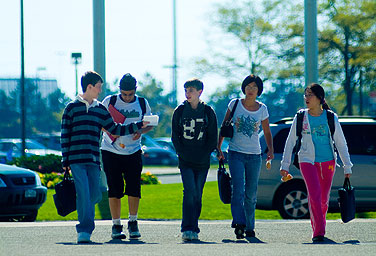News
International students enrich economy

NAFSA: Association of International Educators estimates that the more than 5,000 international students who attended UB during 2011-12, and their dependents, contributed more than $100 million to the Western New York economy.
The 5,357 international students who attended UB in the 2011-12 academic year and their dependents contributed approximately $108,419,700 to the Western New York economy, according to the 2012 report issued last week by NAFSA: Association of International Educators.
“We are very, very pleased that so many highly talented students from around the world choose UB for their studies and are grateful for the considerable economic benefit they offer to local businesses and communities,” says Stephen Dunnett, vice provost for international education at UB.
“Although this report focuses on their fiscal impact, international students also greatly enrich the cultural life of our campuses and, through out-of-state tuition largely funded by non-U.S. sources, provide financial support for on-campus programming for all our students.
“They also bring important global perspectives into American classrooms,” Dunnett adds, “and help build strong and lasting bridges between their countries and cultures that benefit the U.S. in ways too numerous to cite here.”
In addition to UB, 15 other higher education institutions in Western New York enrolled a total of 2,148 international students in 2011-12, with an economic contribution to the region of $70,291,000.
Those institutions are Daemen College, Erie Community College, Genesee Community College, Niagara County Community College, Brockport State College, Geneseo State College, Canisius College, D’Youville College, Hilbert College, Jamestown Community College, Buffalo State College, Fredonia State College, Trocaire College, Villa Maria College of Buffalo and Niagara University.
NAFSA arrived at its economic-contribution data by adding tuition and fees paid by a school’s international students in 2011-12 ($71,519,200 in the case of UB) and living expenses of students and dependents ($89,966,400 for UB), then deducting financial support provided to the students by the U.S. ($53,095,800 for UB).
In estimating the economic contribution of international students to Western New York, NAFSA says the analysis does not rely on a multiplier effect because, although it might provide a more accurate estimate of actual economic impact, there is no consensus on the appropriate size of such a multiplier.
Therefore, figures are conservative. They derive from enrollment figures from the Institute of International Education’s “Open Doors 2012” report; tuition figures from Wintergreen Orchard House, a major database compiler, provider and publisher of educational data that provides cost figures for tuition, living and miscellaneous expenses at U.S. colleges and universities for the 2011-12 academic year; and overall analysis of the data by Jason Baumgartner, director for information services at the Indiana University, Bloomington, Office of International Services.

Reader Comments
Maya Shermer says:
While glad to hear of the large contributions being made to WNY's economy, I urge UB to do more for int. students and the larger community as it pushes forward with the UB2020 plan and into the new year. International students are great in more ways to count and as a good MUP friend said as we returned to Buffalo from our travels passing the "An All America City" sign: "I am so glad to be home." UB needs to help make the transition for international students smoother while helping the economy for all. The downtown campus is a start to revitalizing the area. Transportation needs to be improved to this campus and further downtown. Increasing student populations are a great economic resource that currently cannot access these areas easily but have the potential to start something great.
Posted by Maya Shermer, MUP Graduate Student, 12/20/12